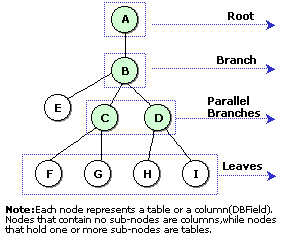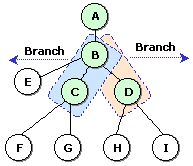

Hierarchical data sources with a parallel structure are also supported by JReport Designer, and are hence called parallel HDS. The difference between the general HDS and the parallel HDS is that the parallel HDS contains more than one parallel branch, which will be presented in different Parallel Detail (PDT) panels in a banded object in JReport Designer.
Data in a parallel HDS is organized in a tree structure, which contains branches and leaves. Among these branches, there are some parallel branch nodes that split the trunk of the data source tree into deeper and more complex branches. The following is a figure illustrating the parallel HDS structure.

Leaf
A leaf in parallel HDS refers to a column (DBField), nodes that contain no sub-nodes.
Branch
A branch in parallel HDS is a special table that contains leaves or sub-branches.

Parallel branches
If the contents of two branches have no parental relationships, these branches are called parallel branches.
Note: The way of using a parallel HDS is the same as with general HDS in JReport Designer. There are however, some key points that you should be aware of when you use a parallel HDS to develop reports. For details, see Example 2: Developing a report from a parallel HDS.